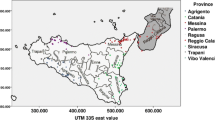Abstract
The equilibrium of the market for offenses is studied by means of a multi-agent based simulation. The results show more detailed properties of the market’s equilibrium compared to the theoretical results derived by Fender [8]. Some preliminary results are described.
Agents may adopt random/mixed strategies, which violate the rational choice theory.
Preview
Unable to display preview. Download preview PDF.
Similar content being viewed by others
References
Abbink, K., Irlenbusch, B., Renner, E.: An Experimental Bribery Game. SFB Discussion Paper B-459 (1999). (http://www.wiwi.uni-bonn.de/sfb/papers/B400-463.html)
Agnew, R.: Foundation for a General Strain Theory of Crime and Delinquency. Criminology, 30 (1992) 47–88.
Becker, G. S.: Crime and Punishment: An Economic Approach. Journal of Political Economy, 76 (1968) 169–217.
Cornish, D. B., Clarke, R. V. (eds.): The Reasoning Criminal: Rational Choice Perspectives on Offending. Springer-Verlag, (1986).
Davis, M.: Time and Punishment: An Intertemporal Model of Crime. Journal of Political Economy, 96 (1988) 383–90.
Ehrlich, I.: Participation in Illegitimate Activities: A Theoretical and Empirical Investigation. Journal of Political Economy, 81 (1973) 521–567.
Ehrlich, I.: Crime, Punishment, and the Market for Offenses. The Journal of Economic Perspectives, 10(1) (1996) 43–67.
Fender, J.: A General Equilibrium Model of Crime and Punishment. Journal of Economic Behavior & Organization, 39 (1999) 437–453.
Glaeser, E., Sacerdote, B., Scheinkman, J.: Crime and Social Interactions. Quarterly Journal of Economics, 111 (1996) 507–48.
Greenfeld, L. A.: Alcohol and Crime. Technical Report, US Dept. of Justice/BCJ NCJ 168632 (1998).
•mrohoro•lu, A., Merlo, A., Rupert, P.: On the Political Economy of Income Redistribution and Crime. Federal Reserve Bank of Minneapolis Research Department Staff Report 216 (1996).
Leung, S. F.: Dynamic Deterrence Theory. Economica, 62 (1995) 65–87.
Marjit, S., Shi, H.: On Controlling Crime with Corrupt Officials. Journal of Economic Behavior & Organization, 34 (1998) 163–72.
Patternoster, R., Simpson, S.: Sanction Threats and Appeals to Morality: Testing a Rational Choice Model of Corporate Crime. Law and Society Review, 30 (1996) 378–399.
Patterson, G., Yoerger, K.: Developmental Models for Delinquent Behavior. In Hodgins, S (ed.), Crime and Mental Disorder. Sage Publications, (1993).
Piquero, A. R., Tibbetts, S. G. (eds.): Rational Choice and Criminal Behavior: Recent Research and Future Challenges. Routledge, (2002).
Piquero, A. R., Hickman, M.: The Rational Choice Implications of Control Balance Theory. In Piquero, A. R., Tibbetts, S. G. (eds.): Rational Choice and Criminal Behavior: Recent Research and Future Challenges. Routledge, (2002) 85–107.
Polinsky, A. M., Rubinfeld, D.: A Model of Optimal Fines for Repeat Offenders. Journal of Public Economics, 46 (1991) 291–306.
Sah, R. K.: Social Osmosis and Patterns of Crime. The Journal of Political Economy, 99(6) (1991) 1272–1295.
Tittle, C. R.: Control Balance: Toward a General Theory of Deviance. Westview, (1995).
Trumbull, W. N.: Estimations of the Economic Model of Crime Using Aggregate and Individual Level Data. Southern Economic Journal, 56 (1989) 423–439.
Vila, B.: A General Paradigm for Understanding Criminal Behavior: Extending Evolutionary Ecological Theory. Criminology, 32 (1994) 311–360.
William, K. R., Hawkins, R.: Perceptual Research on General Deterrence: A Critical Review. Law and Society Review, 20 (1986) 545–572.
Winoto, P.: A Multi-Agent Based Simulation of the Market for Offenses. AAAI-02 Workshop on Multi-Agent Modeling and Simulation of Economic Systems, Edmonton, Canada, Technical Report WS-02-10, AAAI Press (2002) 66–71.
Witte, A. D.: Estimating the Economic Model of Crime with Individual Data. Quarterly Journal of Economics, 94 (1980) 57–84.
Author information
Authors and Affiliations
Editor information
Editors and Affiliations
Rights and permissions
Copyright information
© 2003 Springer-Verlag Berlin Heidelberg
About this paper
Cite this paper
Winoto, P. (2003). A Simulation of the Market for Offenses in Multiagent Systems: Is Zero Crime Rates Attainable?. In: Simão Sichman, J., Bousquet, F., Davidsson, P. (eds) Multi-Agent-Based Simulation II. MABS 2002. Lecture Notes in Computer Science(), vol 2581. Springer, Berlin, Heidelberg. https://doi.org/10.1007/3-540-36483-8_13
Download citation
DOI: https://doi.org/10.1007/3-540-36483-8_13
Published:
Publisher Name: Springer, Berlin, Heidelberg
Print ISBN: 978-3-540-00607-7
Online ISBN: 978-3-540-36483-2
eBook Packages: Springer Book Archive




